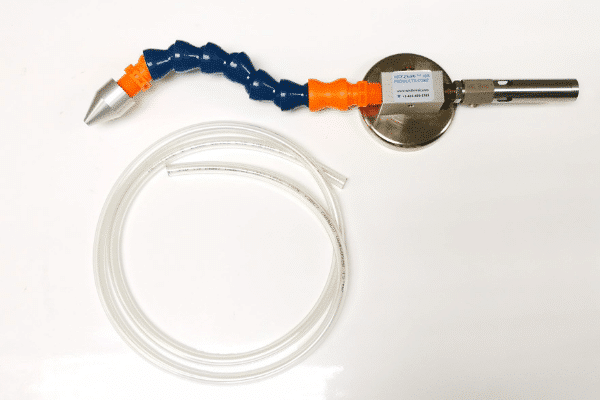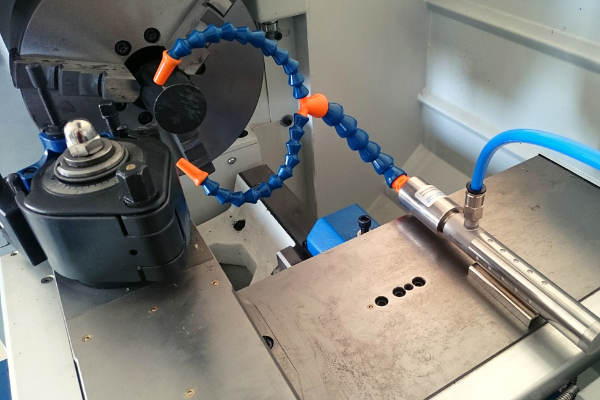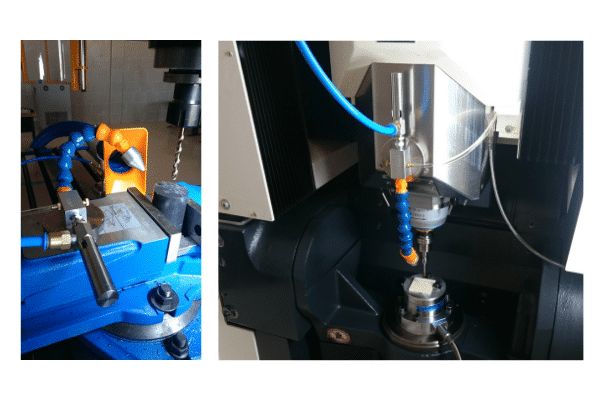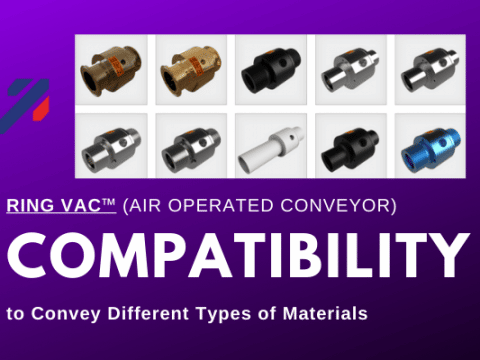
5 Ways a Tool Cooler is used to Improve Factory Efficiency
A tool cooler is a packaged vortex tube to make it more easily used. A vortex tube creates very cold, and even freezing temperatures from compressed air for spot cooling. By itself, the vortex tube is quite noisy so accessories to muffle the sound of the device is usually required. The tool cooler consists of a vortex tube with a cold end muffler, and a hot end sleeve (to protect from the heat generated at the hot end) which also incorporates some muffling. In addition, a strong magnet is added onto the unit to easily attach it to any magnet accepting surfaces like a machine or steel table to secure the unit in place. So this “packaged” vortex tube is now quiet, easy to handle and more flexible to use.
Normally a vortex tube by itself has an adjustable hot end plug to control the flow of cold air out the cold and hot ends, and to vary the temperature produced at the cold end. But there is an “optimum setting” that will give you the maximum cooling effect and at the same time keep the temperature just above zero degrees C. This is to prevent any possible freezing in the device should the dew point for your compressed air supply is not very low. For sub-zero temperature generation you should have dry air with a dew point below that of the temperature you wish to produce in the vortex tube.
- The most common use for a Tool Cooler is of course for cooling the tool used for drilling, grinding, milling and routing especially for materials that are not allowed to have liquid for cooling for various reasons like the liquid being detrimental to the material or for reason such as avoiding contamination. This would be for plastics, glass, ceramics, titanium and other special materials.In fact there is an entire movement to replace coolant normally used as much as possible due to the high disposal cost of coolant and for environmental considerations. Much has and is being driven towards dry or semi-dry machining which involves significant machine design changes as well since liquid coolant not only cools, but cleans away the chips and waste produced in the machining operation.

Tool coolers or variations such as our mist cooler, which offers some lubrication are becoming more popular. But for materials that have always been dry machined such as plastics, the benefits are faster machining (shortens production time and increases output) and better quality, especially with plastics as it produces less waste in the cut (a much cleaner cut). Tool life can be extended as well in carbide tipped tools because the cold air produced helps prevent micro-carbon cracking.
- Setting Hot Melt Adhesives is another common use for the tool cooler. When applying adhesives, the cold temperature helps to set the glue faster and allowing for a faster throughput. In one application (which I cannot detail due to secrecy), has a continuous line of adhesive applied and required rapid cooling which several tool coolers along the length of the process was able to provide. The customer utilized adjustable vortex tubes prior but the problem was actually personnel continually adjusting. As such, some devices were adjusted for higher flow, some for colder temperature but – what slipped the mind is – consideration for the cooling effect change. Our tool cooler is set for optimum cooling and took this issue out of the equation. Nex Flow do also offer adjustable spot coolers in cases where some temperature control is needed.
- In line slitting, is a variation in tool cooling in that you are applying the cold air flow to a cutting blade in a slitting operation. The advantage here is not for increasing output, but to have the sharpness of the blade last longer. There is a very noticeable improvement when thicker material need to be slit as the blade would have to work harder and can heat up more. The vortex tube operated tool cooler keeps the temperature down, and extends the blade life. As with the adhesive application, the tool cooler is preset to give the optimum cooling effect to prevent tampering with the unit and maintaining consistency in cooling to control the quality of the adhesive application.

- Laser cutting is an application where the tool cooler is very effective. For the laser processing of materials, the material changes in the heat affected zone (HAZ) is an important indicator for quality in microelectronics manufacturing. In laser cutting you focus beams to heat the surface of the material up to a high temperature to melt the material and you want to minimize the HAZ. The cooling from the tool cooler decreases potential burning in the heat affected zone area thereby improving quality. As there is no refrigerant involved, there is no effect on the environment. The low temperature cooling air diminishes the HAZ in laser cutting for glass fiber reinforced composite materials for example.
- Chill roll nip cooling is where the Tool Cooler is placed on the nip roll of a plastic film web processing line. Nip rollsor pinch rolls are powered rolls that are used to press two or more sheets together to form a laminated product. The high pressure created at the nip point brings the sheets into intimate contact, and can squeeze out any bubbles or blisters that might cause a defective bond. If the material is too warm it can stick and if the material is very thick or cooling is uneven, there could be a hot spot causing defects which is easily eliminated by using a Tool Cooler.
In all these applications there is no requirement for lubrication. However, there are applications where some lubrication is absolutely necessary. One example is drilling a deep hole into a material. Without some lubrication to the cutting tool, it will bind inside the material being drilled. For this reason Nex Flow developed the patented Mist Cooler which operates not by cooling the tool directly, but by cooling the lubricant applied to the cutting tool to a very low temperature. The liquid is applied as a mist to the cutting tool to provide both the lubrication and cooling it needs. The benefit is the diminished volume of liquid needed to both cool and lubricate. Reduction in chemical use can be as much as 20%, a significant savings even over a short time frame.

Tool Coolers are available in various capacities for cooling depending on the nature of the material being cooled, the rate of throughput and the thickness of the material. There is even a small capacity unit called a Mini Cooler which is used in cutting thin material, and even in sewing operations involving heavy textiles such as jeans and burlap bags where the sowing needles heat up and deform or break thread. The mini cooler keeps them cool. While it is generally a good idea to avoid any adjustable system (as the fixed systems are preset for optimum cooling), the Adjustable Spot Cooler is another packaged vortex tube, very similar to the Tool Cooler but with an easy hand adjustable knob to vary the temperature at the outlet that is available. This is usually used in laboratory applications and for testing where temperature variation is required. Tool Coolers (and other variations) can be specially made to provide sub-zero temperatures if required. The versatility of the Tool Coolers makes it an excellent packaged option for all types of spot cooling applications.








